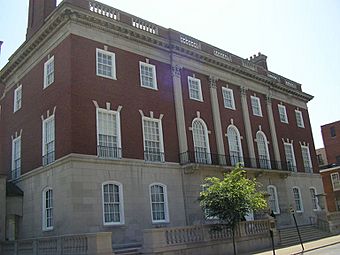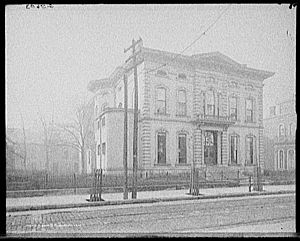Pendennis Club facts for kids
| Private club | |
| Founded | 1881 |
| Headquarters | 218 W. Muhammad Ali Blvd., Louisville, Kentucky 40202 |
The Pendennis Club is a special private club located in Louisville, Kentucky. It started in 1881, like the famous clubs in London, England. Many people see the Pendennis Club as one of the best social clubs in Kentucky and even in the United States.
Contents
Founding the Club
The Pendennis Club was started by Thomas Wilson Todd, Levi Bloom, John Smith Noyes, and William Whits Hite. They met with sixteen other people in Mr. Todd's office in Louisville City Hall on June 28, 1881, to plan the club.
The first meetings were held in a rented space above a grocery store. This spot is now where the Seelbach Hotel stands. The club's first president, Maj. John Montgomery Wright, was chosen at one of these meetings. He was a veteran of the Civil War and later worked for the United States Supreme Court.
The members decided to name the club after a character named Arthur Pendennis from a book by William Makepeace Thackeray. Arthur Pendennis was seen as a perfect club member. The club also chose a crest and a motto, nec tenui penna, which means "with unfailing wings." This crest was even put on bottles of Kentucky Bourbon sold to members.
The First Clubhouse (1883–1928)
The club grew very quickly, and many important people from Louisville joined. In 1883, the club bought its first permanent home. This was the house of William Burke Belknap, who founded Belknap Hardware.
The new clubhouse opened on August 1, 1883. On the same day, U.S. President Chester A. Arthur visited Louisville for the Southern Exposition. That evening, President Arthur and some of his cabinet members, including Robert Todd Lincoln, had a fancy dinner at the Pendennis Club. Other U.S. Presidents who visited the club include Theodore Roosevelt, William Howard Taft, and Woodrow Wilson.
President Taft, who was from Cincinnati, Ohio, reportedly felt very comfortable at the Pendennis Club. A famous journalist, Arthur Krock, once said that the Pendennis Club had more true "gentlemen" than almost any other club. He meant civilized, educated, and well-mannered people.
Another famous visitor was Frederick Law Olmsted, who designed New York City's Central Park. In 1891, he met with Louisville leaders at the club to discuss his plan for the city's park system. A club member, Andrew Cowan, helped make this park project happen.
In 1895, the Duke of Marlborough visited the club. Also, a song called "Pendennis 2-Step" was created that same year.
Henry Bain, a Club Legend
In 1884, Henry T. Bain joined the club staff. He started as an "elevator boy" but soon became a very important person, perhaps the club's first head waiter (Maitre d'). He was known for his polite manners and amazing memory for names.
Barry Bingham, Sr., a newspaper publisher and club member, said that Henry Bain knew everyone in "Louisville society" and their family backgrounds. Henry retired in 1924 and passed away just before the new clubhouse opened in 1928.
Henry Bain's most famous legacy is the special sauce he created for meat, known as Henry Bain sauce. He sold the recipe to the club, and they still own the trademark. This sauce is still enjoyed by club members and is even sold in local stores today.
A relative of Henry Bain, Roland Hayes, who was a famous singer, performed at the club in 1910.
Club Drinks and History
The Pendennis Club is known for its history with mixed drinks. It has a special drink named after it, the Pendennis Club Cocktail. There's also a long-standing story that the club invented the Old Fashioned drink.
A book from 1911 lists six mixed drinks served at the Pendennis Club. These included the Pendennis Cocktail, Pendennis Mint Julep, and an Old Fashioned Toddy. Even during Prohibition (when alcohol was illegal), some club members still enjoyed their drinks. In 1930, the club was raided, and many bottles of drinks were taken away.
The Old Fashioned Story
For a long time, people believed the Old Fashioned drink was invented at the Pendennis Club. However, many drink historians say this is a myth for a few reasons.
First, the term "old fashioned cocktails" was mentioned in newspapers in 1880, before the Pendennis Club even opened. Second, the basic recipe for this drink had been around for many years. The name "old fashioned" just meant people wanted the simple, original way of making a cocktail.
A book from 1913 by the club's former manager doesn't list an Old Fashioned drink or say it was invented at the club. It does list an "Old Fashioned Toddy," which is similar but without bitters.
Despite this, a story from 1931 by Albert Stevens Crockett of the Waldorf-Astoria hotel said the Old Fashioned was invented by a bartender at the Pendennis Club. He said it was introduced to New York by Colonel James E. Pepper, a club member. Club stories also say Colonel Pepper helped bring the Old Fashioned to New York City.
Two bartenders who worked at the club are sometimes linked to the drink. Jacques Straub, who became the club's manager, published a drink book in 1913. Tom Bullock, another bartender, published his own drink book in 1917. Neither book specifically credits the Old Fashioned to the Pendennis Club.
The Old Fashioned drink made at the Pendennis Club today uses sugar, water, Angostura bitters, and good Bourbon whiskey. It also includes an orange slice, a cherry, and a lemon twist.
The New Clubhouse
|
Pendennis Club
|
|

The modern clubhouse in Downtown Louisville
|
|
| Location | Louisville, Kentucky |
|---|---|
| Built | 1928 |
| Built by | Wortham Construction Company |
| Architect | Nevin, Wischmeyer and Morgan |
| Architectural style | Colonial Revival |
| NRHP reference No. | 03001225 |
| Added to NRHP | December 4, 2003 |
The Pendennis Club built its current clubhouse in 1927–1928, just a block from its first location. This beautiful building is designed in the Georgian Revival style and has almost 80,000 square feet of space. It was designed by a Louisville firm called Nevin, Wischmeyer & Morgan.
The architect, Mr. Nevin, said the new building, which cost $1 million, was meant to be "one of the finest club buildings in the country." He made sure only the best materials were used. The building still stands as one of the best clubhouses in the United States. It has many Georgian architectural details and even two rooms with famous French wallpaper. It opened to members on December 11, 1928.
A photo of the club's amazing library was in New Yorker Magazine in 1948. It showed the room with its large tables, comfy red leather chairs, and shelves of classic books reaching the ceiling. The room looks very much the same today.
The front of the clubhouse was added to the National Register of Historic Places in 2003. Today, the club's billiard room, with its walnut walls and teak wood floor, is one of the few grand billiard rooms in the U.S. still used for its original purpose. The sport of Squash was first played in Louisville at the Pendennis Club in 1930.
Working Towards Fairness
Even though one of the club's founders, Levi Bloom, was Jewish, the club did not accept another Jewish member until 1974. This was more than 90 years after it started. Some important club members even left the club because their Jewish friends were not allowed to join.
By 1991, the club still had not accepted any African-American members. Louis Coleman Jr., a local civil rights activist and pastor, protested this by eating lunch outside the club.
That same year, Mr. Coleman filed complaints with the Kentucky Commission on Human Rights (KCHR). He said the Pendennis Club and two other clubs were unfair in how they chose members.
The KCHR first said they couldn't act because Kentucky law allowed private clubs some freedom in choosing members. However, later legal decisions led to a case where the Supreme Court of Kentucky ruled that while the Pendennis Club could choose its members, it could not allow members to get tax breaks if the club was found to be unfair. This decision meant the KCHR could investigate the club to see if this rule should apply. This ruling came out in 2004.
Special Events
The Pendennis Club has hosted many important social events over the years. These include parties for young women making their social debut.
Since at least 1941, the club has sometimes held boxing nights. A boxing ring was set up in the club's large ballroom. On February 19, 1960, a young Cassius Clay, who later became Muhammad Ali, fought in one of these events. He won his match. Later that year, he went to the Olympics and became a professional boxer. It's interesting to know that at least five of the people who helped support Muhammad Ali in his early boxing career were members of the Pendennis Club.
The club's ballroom was also used as a filming location for the 2010 Disney movie Secretariat. It was the setting for the "Belmont Ball" scene.
Many club events also happen around the time of the annual Kentucky Derby horse race. Famous people and even royalty have been guests at the club for these events, especially at its popular Post Derby Party on the night of the race.
See also
- List of American gentlemen's clubs


